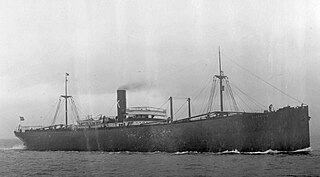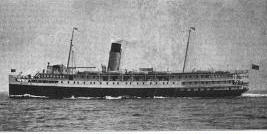
CP Ships was a large Canadian shipping company established in the 19th century. From the late 1880s until after World War II, the company was Canada's largest operator of Atlantic and Pacific steamships. Many immigrants travelled on CP ships from Europe to Canada. In 1914 the sinking of the Canadian Pacific steamship RMS Empress of Ireland just before World War I became largest maritime disaster in Canadian history. The company provided Canadian Merchant Navy vessels in World Wars I and II. Twelve vessels were lost due to enemy action in World War II, including the RMS Empress of Britain, which was the largest ship ever sunk by a German U-boat.

SS Princess Sophia was a steel-built passenger liner in the coastal service fleet of the Canadian Pacific Railway (CPR). Along with SS Princess Adelaide, SS Princess Alice, and SS Princess Mary, Princess Sophia was one of four similar ships built for CPR during 1910-1911.

Storstad was a steam cargo ship built in 1910 by Armstrong, Whitworth & Co Ltd of Newcastle for A. F. Klaveness & Co of Sandefjord, Norway. The ship was primarily employed as an ore and coal carrier doing tramp trade during her career. In May 1914 she accidentally rammed and sank the ocean liner RMS Empress of Ireland, killing over 1,000 people.

RMS Empress of Japan, also known as the "Queen of the Pacific", was an ocean liner built in 1890–1891 by Naval Construction & Armaments Co, Barrow-in-Furness, England for Canadian Pacific Steamships (CP). This ship – the first of two CP vessels to be named Empress of Japan – regularly traversed the trans-Pacific route between the west coast of Canada and the Far East until 1922. During the First World War she served as armed merchant cruiser, becoming HMS Empress of Japan for the period that she was a commissioned ship of the Royal Navy.

The Grand Trunk steamship Prince Rupert and her sister ship SS Prince George served the coast of British Columbia and Alaska. Prince Rupert had a 45-year career serving northern ports from Vancouver, British Columbia, from 1910 to 1955. The ship was considered "unlucky" and suffered several incidents during her career, including two significant ones that left large portions of the vessel underwater. The ship was broken up in 1956.

James William Troup was an American steamship captain, Canadian Pacific Railway administrator and shipping pioneer.

RMS Empress of China was an ocean liner built in 1890-1891 by Naval Construction & Armament Co., Barrow, England for Canadian Pacific Steamships (CP). This ship—the first of three CP vessels to be named Empress of China—regularly traversed the trans-Pacific route between the west coast of Canada and the Far East until she struck an underwater reef and sank in Tokyo harbour in 1911.

RMS Empress of India was an ocean liner built in 1890-1891 by Naval Construction & Armaments Co, Barrow-in-Furness, England for Canadian Pacific Steamships. This ship would be the first of two CP vessels to be named Empress of India, and on 28 April 1891, she was the first of many ships named Empress arriving at Vancouver harbor.

RMS Empress of Scotland, originally SS Kaiserin Auguste Victoria, was an ocean liner built in 1905–1906 by Vulcan AG shipyard in Stettin for the Hamburg America Line. The ship regularly sailed between Hamburg and New York City until the outbreak of war in Europe in 1914. At the end of hostilities, re-flagged as USS Kaiserin Auguste Victoria, she transported American troops from Europe to the United States. For a brief time Cunard sailed the re-flagged ship between Liverpool and New York.

SS Princess Helene was a passenger and cargo ferry operated by the Canadian Pacific Railway (CPR).

MV Princess of Vancouver was a passenger vessel in the Pacific coastal service fleet of the Canadian Pacific Railway (CPR).

SS Princess Alice was a passenger vessel in the coastal service fleet of the Canadian Pacific Railway (CPR) during the first half of the 20th century.

The Canadian Pacific Railway Coast Service, also known as the British Columbia Coast Steamships (BCCS), was a division of Canadian Pacific Railway (CPR), which began operating Pacific coastal shipping routes in the late 19th century. The development of coastal passenger and cargo shipping routes extended from British Columbia to Alaska and to Seattle, Washington in the United States.

SS Princess Mary was a passenger vessel in the coastal service fleet of the Canadian Pacific Railway (CPR) during the first half of the 20th century.

Princess Norah was a steamship which operated in British Columbia and southeastern Alaska from 1929 to 1964. From 1955 to 1958, this ship was called Queen of the North. From 1958 to 1964, the ship was called Canadian Prince. This ship should not be confused with the later similarly named motor ferry MV Queen of the North.

Princess Beatrice was a steamship built for and owned by the marine division of the Canadian Pacific Railway (CPR). The ship served from 1903 to 1928 in the coastal waters of British Columbia. The ship also operated on Puget Sound on a route from Victoria, British Columbia to Seattle, Washington. Princess Beatrice was the first ship to operate in the year-round steamship service between Seattle and Victoria that was run by CPR from 1904 to 1959. This ship should not be confused with an earlier Princess Beatrice, built in Scotland in 1874, which served on the Atlantic coast of Canada.

Princess May was a steamship built in 1888 which was operated under a number of different names and owners. The ship is best known for having been involved in a grounding in 1910 which left the ship jutting completely out of the water, which became the subject of a famous shipwreck photograph.

Princess Marguerite, Princess Marguerite II, and Princess Marguerite III was a series of Canadian coastal passenger vessels that operated along the west coast of British Columbia and into Puget Sound in Washington state almost continuously from 1925 to 1999. Known locally as "the Maggie", they saw the longest service of any vessel that carried passengers and freight between Victoria, Vancouver, and Seattle. The vessels were owned and operated by a series of companies, primarily Canadian Pacific Railway Company (CPSS) and British Columbia Steamships Corporation. The first two were part of the CPR "Princess fleet," which was composed of ships having names which began with the title "Princess". These were named after Marguerite Kathleen Shaughnessy, who was not a princess but was the daughter of Baron Thomas Shaughnessy, then chairman of the board of CPSS's parent, the Canadian Pacific Railway (CPR).
The SS Princess Louise was a 331-foot steamship, named in honor of Louise, Princess Royal and Duchess of Fife, Queen Victoria's granddaughter. The ship was part of the Canadian Pacific Railway's "Princess" fleet, the coastal counterparts to CPR's "Empress" fleet of passenger liners which sailed on trans-Pacific and trans-Atlantic routes. The ships of the British Columbia Coast Steamships came to be called "pocket liners" because they offered on smaller vessels the superior class of service, splendid amenities and luxurious decor equal to great ocean liners.


















